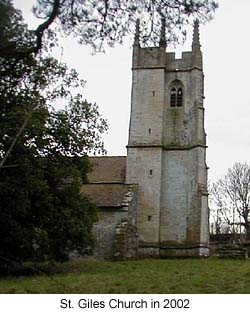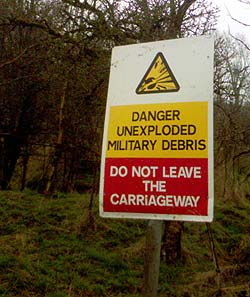Imber - The Town That Got Conscripted
by Dawn Copeman
During the Second World War everyone had to make sacrifices. Many thousands of people lost their homes to enemy action, but when the inhabitants of Imber in Wiltshire lost their homes it was not to the enemy but to the British Army. Not that the houses were destroyed; they weren't. They were just, shall we say, conscripted.
 On November 1st 1943, the inhabitants of Imber were given 47 days notice to leave their village. The War Office needed the village as a place for American forces to practise fighting in built-up areas prior to the D-Day Landings. The villagers did their duty and left their homes; after all, it was only for the duration of the war and everyone was used to making sacrifices. However, when the war ended, the army had become too attached to Imber and decided not to leave.
On November 1st 1943, the inhabitants of Imber were given 47 days notice to leave their village. The War Office needed the village as a place for American forces to practise fighting in built-up areas prior to the D-Day Landings. The villagers did their duty and left their homes; after all, it was only for the duration of the war and everyone was used to making sacrifices. However, when the war ended, the army had become too attached to Imber and decided not to leave.
Imber was, until then, just another little village in Wiltshire. Historians believe it was first settled by the ancient Britons, probably for sheep farming, and several tracks dating back to Roman times have been found in and around the village. By Saxon times the village of Imber was well known; references have been found to it in a text from 967AD and in the Doomsday book it is listed as having a population of fifty.
By the time the army took the village over, the population was 150. Being located in the middle of Salisbury Plain, Imber never did have a very large population. There was no real reason for people to settle here unless they were working the surrounding fields or providing services for those who did. Imber's highest population figure was recorded in the census of 1851, when the total reached 450. For the most part, however, Imber was a sleepy, little agricultural village surrounded by fields.
But others had their eyes on this land. In 1897, the War Office began buying up parcels of land to the east of Imber to use as a training ground for the army. By 1902 they owned 43,000 acres. After the First World War, during the agricultural depression of the 1920's and 1930's, the war office took advantage of farmers' need for cash and bought up huge tracts of land for relatively low prices. Between 1928 and 1932 they not only owned all the land surrounding Imber, they also owned the land the village sat on. An area of Salisbury plain measuring 25 miles by 10 miles was now in the hands of the army.
Thus no-one could really complain when their landlords, the army, asked them to leave Imber. At first, they were told that the army would only need the land for six months; then it became the duration of the war. The residents weren't given much in the way of compensation, but then again, no-one really expected it. What they did expect was to be able to return to their homes and businesses after the war.
At first, it seemed as though they would be able to. Shortly after the war the army made attempts to re-build and repair the houses that had been damaged during their manoeuvres, but then they decided to not to let the villagers back.
 The exiled villagers didn't take this lying down. They organised rallies and eventually took the army to court. The battle for Imber continued until 1961 when a Public Inquiry awarded Imber to the army. Shortly afterwards the House of Lords ruled that although Imber was now a vital army training area, the church of St Giles, Imber's Parish church founded in the 13th century, would be maintained and be open for services for people for at least one day a year, the Sunday closest to St Giles' Day.
The exiled villagers didn't take this lying down. They organised rallies and eventually took the army to court. The battle for Imber continued until 1961 when a Public Inquiry awarded Imber to the army. Shortly afterwards the House of Lords ruled that although Imber was now a vital army training area, the church of St Giles, Imber's Parish church founded in the 13th century, would be maintained and be open for services for people for at least one day a year, the Sunday closest to St Giles' Day.
And so it is. In fact, Imber is open to the public for fifty days a year. Visitors can access it during the Easter and Christmas periods and throughout the month of August. But, if apart from the church, most of the village has been destroyed, is there anything left worth seeing there?
The answer is yes. The village, although now somewhat decrepit, still stands. It is, in fact, a museum you can walk around. Where else in Britain can you get such a feel for life gone by? Here you can walk along the street with the stream running through and experience, albeit briefly, rural life as it once was. The church, although damaged by lightning in 2003, still stands and although the parish of Imber has been abolished, the church is still consecrated and is maintained by the Churches Conservation Trust. Interestingly, despite having no registered electors, Imber is still represented in Parliament by the MP for Westbury.
And if you do go to visit Imber, why not also take the time to see some more of Salisbury Plain? This is not a barren, empty army training ground; far from it. Because this land is in the control of the army, it has not been developed. In this way an archaeological landscape that dates back over 6000 years has been preserved for all to see. Salisbury Plain contains Britain's largest collection of ancient long and round barrows. It also contains some 2,300 ancient monuments, 550 of which are protected by law and six of which are classified as important fragile sites. Some 50,000 acres of the Plain have been designated as Sites of Special Scientific Interest and the remainder of the Plain is home to a wide variety of animals and plants that have been lost to progress in the rest of the country. A visit to Imber and Salisbury Plain is a journey back in time in more ways than one.
Getting to visit Salisbury Plain is surprisingly easy. The Army is keen to give public access to its land on public rights of way. The only areas that are out of bounds are those areas where live firing is taking place. Simply check your map and off you go to discover a Britain that for the rest of us was lost over 60 years ago.
More Information:
We regret that we no longer have the resources to maintain up-to-date links and/or hours and pricing details for the various sites and attractions listed on this website. For more information about the location(s) listed above, please use your favorite search engine or visit Wikipedia.
Dawn Copeman is a freelance writer and commercial writer who has had more than 100 articles published on travel, history, cookery, health and writing. She currently lives in Lincolnshire, where she is
working on her first fiction book. She started her career as a freelance
writer in 2004 and has been a contributing editor for several publications, including TimeTravel-Britain.com and Writing-World.com .
Article © 2007 Dawn Copeman
Photos courtesy of Wikipedia.org
|
